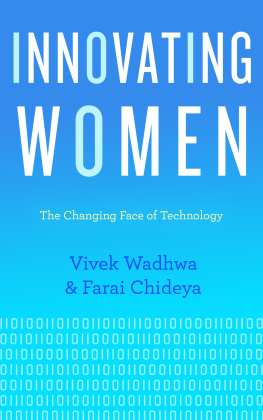
The Future of Tech Is Female
Also by the Author
Corporate Governance (1993)
Forensic Social Work (with R. Barker) (1994) (2d ed. 2000)
Problems in Corporate Governance (1997)
Understanding Corporate Law (with A. Pinto) (1999) (2d ed. 2004) (3rd ed. 2009) (4th ed. 2013) (5th ed. 2018)
Boardroom Chronicles (2002)
Questions and Answers: Business Associations (2004) (2d ed. 2012)
No Seat at the Table: How Corporate Governance and Law Keep Women Out of the Boardroom (2007)
Business Enterprises: Legal Structures, Governance, and Policy (with J. Heminway et al.) (2009) (2d ed. 2012) (3rd ed. 2016)
The Last Male Bastion: Gender and the CEO Suite in Americas Public Companies (2010)
The Sage Handbook of Corporate Governance (2012) (with T. Clarke)
Three Tastes of Nuoc Mam: The Brown Water Navy and Visits to Vietnam (2012)
Greatness in the Shadows: Larry Doby and the Integration of the American League (2016)
The Future of Tech Is Female
How to Achieve Gender Diversity
Douglas M. Branson

NEW YORK UNIVERSITY PRESS
New York
NEW YORK UNIVERSITY PRESS
New York
www.nyupress.org
2018 by New York University
All rights reserved
References to Internet websites (URLs) were accurate at the time of writing. Neither the author nor New York University Press is responsible for URLs that may have expired or changed since the manuscript was prepared.
Library of Congress Cataloging-in-Publication Data
Names: Branson, Douglas M., author.
Title: The future of tech is female : how to achieve gender diversity / Douglas M. Branson.
Description: New York : New York University, [2018] | Includes bibliographical references and index.
Identifiers: LCCN 2017044870 | ISBN 9781479875177 (cl : alk. paper)
Subjects: LCSH: Information technologyManagement. | Personnel management. | Women executivesRecruiting. | WomenEmployment.
Classification: LCC HD30.2 .B73 2018 | DDC 004.068/4dc23
LC record available at https://lccn.loc.gov/2017044870
New York University Press books are printed on acid-free paper, and their binding materials are chosen for strength and durability. We strive to use environmentally responsible suppliers and materials to the greatest extent possible in publishing our books.
Manufactured in the United States of America
10 9 8 7 6 5 4 3 2 1
Also available as an ebook
To the women in my life: Madeline, Clare, Freya, Annie, and Elizabeth
Contents
Recently, tech leaders Apple and Google passed Coca-Cola as possessing the most well-known and second most well-known trademarks in the world.
Yet tech is the most backward of major industries in promoting women to leadership positions or positioning them for future ascension into executive positions. Even lower down in the ranks, the number of women tech companies employ has declined from 37 percent of employees in 1995 to 24 percent today (2016), with prognostications that the number will decline further, to 22 percent or lower in the next decade.
Higher up, in leadership ranks, as revealed in compensation tables that companies file with the Securities and Exchange Commission (SEC), women account for only 5 percent of the most highly paid tech company executives (see chapter 1). The underrepresentation of womenand the lack of diversity overallis stark and noteworthy.
Furthermore, despite awareness of the issues involved within the industry, the situation does not improve. Jodi Kantor of the New York Times titled her 2014 in-depth study A Brand New World in Which Men Ruled: Instead of Narrowing Gender Gaps, the Technology Industry Created Vast New Ones.
By way of comparison, women constitute 19.2 percent of directorships in large corporations generally, 19 percent of Congress, 21 percent of
In information technology, of those women in executive positions, a supermajority of them have law degrees (JDs) or masters degrees in business administration (MBAs), leading one to question the headlong push for STEM (science, technology, engineering, and mathematics) education for women. Or, at least, educators should consider modifying the STEM emphasis in ways more conducive to assumption of leadership roles.
I had originally planned to title this book The Boo List and the Paradox, referring to what had attracted me to the subject in the first place, namely, that while only 5 percent of senior executives in tech are female (the boo list), compared with 25 percent for U.S. public companies generally, twelve large IT corporations have had female CEOs (the paradox). But the present title helps in better answering the question early reviewers posed: Who is the audience? Throughout, the book emphasizes that the audience is the industry and companies within it. In contrast, the books on the market today, especially emerging over the last two decades, are all first and foremost advice and how-to books for aspiring women. A recent leader in that regard, featured on the cover of Time no less, was Sheryl Sandbergs Lean In (2013). Chapter 8 lists many of those how-to and advice books for women.
A second set of books on diversity in information technology aims at educators and academic institutions, telling them what they should do to encourage and train girls and young women. Chapter 6 reviews certain of those.
But few authorsmaybe nonehave written extensively about a third subject, what the industry and individual companies within it might do. Those who do write about the area have given the industry a free pass. Its high time for observers, pundits, and scholars to turn the spotlight on the corporations themselves. With the illumination so provided, finger pointingindeed, a significant amount of finger pointingis in order. What can and should the industry and companies within it be considering, evaluating, and possibly adopting to solve this social and economic problem, one with significant ramifications for tech businesses and their shareholders?
A question that seemingly always arises is, Why women? Betty Friedans The Feminine Mystique appeared in 1963. Soon after, once the womens movement had taken root, leaders of business and corporate boards made statements and promises on the equality of women in their organizations, promises that nearly fifty years after have only partially been fulfilled in some instances, and not at all in others. The issue has been with us for a half century, but another group of leaders and spokesmen, uniformly men, continue to ask the Why women question, over and over again.
Although not a primary subject for this book, there are a number of reasons to encourage diligent efforts to include more females on promotion ladders and in senior positions:
- > Role Models within Organizations. Women as directors and senior managers serve as important role models to the manifold numbers of women lower down in todays workforces, including 50 percent of the middle managers who today are female.
- > Avoidance of Excessive Risk. The near-death economic experience of 2008-2009 taught the perils of excessive risk and the disregard of sustainability considerations. Women are more aware of and in tune with risk. They are better judges of risk. Christine LaGarde, managing director of the International Monetary Fund, said it well, remarking that if Lehman Brothers had been Lehman Sisters, the august financial firm would still exist.
Next page

















